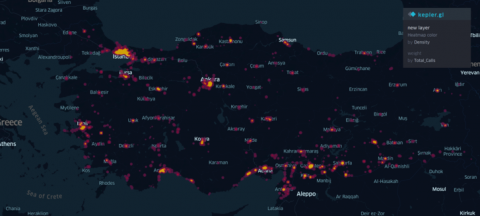
When refugees use their mobile phones they leave clues about how well they are integrating (or not) into their host country. Clio Andris, assistant professor of geography in the College of Earth and Mineral Sciences, is analyzing a year’s worth of phone calls to find the clues to help address the Syrian refugee crisis in Turkey.
“We responded to the Data for Refugees (D4R) Challenge which provides researchers with call data records (CDR) collected during the 2017 calendar year. Researchers tend to get excited about CDR data because they show human calling, texting and mobility patterns at a very fine grain level. The data challenge is a great opportunity,” Andris said. “And equally compelling is a real opportunity to help refugees.”
The CDR data does not include personal information about the callers or the content of the phone calls. “The identification of the phone numbers have been masked, and we don't have extensive mobility data about anyone,” Andris said.
There are 3.5 million Syrian refugees living in Turkey, who have fled since the beginning of the civil war in 2011, according to the U.N. High Commissioner for Refugees.
Andris and team received a seed grant from Penn State’s Social Science Research Institute (SSRI) to analyze call data records from a Turkish telecom company. The multi-college research team also includes Carleen Maitland and Zhenhui (Jessie) Li, both associate professors in the College of Information Sciences and Technology, and Guangqing Chi, associate professor of rural sociology and demography and public health sciences in the College of Agricultural Sciences.
The data are supplied by Turk Telekom, in partnership with the Scientific and Technological Research Council of Turkey (TUBITAK) and Bogazici University, and in collaboration with several academic and non-governmental organizations, including UNHCR Turkey, UNICEF, and the International Organization for Migration.
“We are going to use the percentage of calls between refugees and non-refugees as a proxy measure of economic and social integration,” Andris said. “The more calls between the groups, the more integrated into the community the refugees may be, as they are part of one another’s social life. We are in the process of crunching those numbers now.” Beichen Tian, a graduate student in geography, is assisting with the project.
“Second, we will geolocate the places that individual refugees who appear to be more integrated tend to visit over a two-week long period to determine what kinds of community resources such as markets, schools, places of worship, government services, etc. are there,” Andris said. “Then we will better understand the types of places and ground conditions in the local environment that tend to correspond to better integration.”
“It’s correlation, not causation,” Andris said. “But the analysis should reveal patterns or rules that can help inform policymakers about which socio-environmental variables are most conducive to refugee integration — at least in Turkey, and possibly in other locations. We also can identify which types of cities, population densities and surrounding populations tend to be conducive to integration.”
This study is just the first step in a larger research project Andris is planning. “Our larger project will investigate what kinds of geographic locales tend to be most conducive to integration. We are hoping to get to talk with more experts on the topic and confirm or verify our data set by speaking with locals involved in refugee life in Turkey,” she said.
According to the call for proposals, the goals of the D4R Challenge are: to contribute to the welfare of the refugee populations; to gain insights on key issues, such as safety and security, health, education, unemployment, social integration and segregation, mobility, and distribution of resources and infrastructure; to aid governments and international bodies model the dynamics of the refugee populations and to discover vulnerabilities (socio-economic vulnerabilities, gaps in education and services, etc.); and to seed further projects, co-created with refugees, resulting in new applications, services and innovative solutions for refugees in Turkey and elsewhere.
The project described was supported by the Social Science Research Institute at Penn State. The content is solely the responsibility of the authors and does not necessarily represent the official views of SSRI.